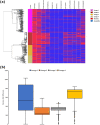Mycobacterium tuberculosis Lineages Associated with Mutations and Drug Resistance in Isolates from India
- PMID: 35442078
- PMCID: PMC9241780
- DOI: 10.1128/spectrum.01594-21
Mycobacterium tuberculosis Lineages Associated with Mutations and Drug Resistance in Isolates from India
Abstract
Current knowledge on resistance-conferring determinants in Mycobacterium tuberculosis is biased toward globally dominant lineages 2 and 4. In contrast, lineages 1 and 3 are predominant in India. In this study, we performed whole-genome sequencing of 498 MDR M. tuberculosis isolates from India to determine the prevalence of drug resistance mutations and to understand the genomic diversity. A retrospective collection of 498 M. tuberculosis isolates submitted to the National Institute for Research in Tuberculosis for phenotypic susceptibility testing between 2014 to 2016 were sequenced. Genotypic resistance prediction was performed using known resistance-conferring determinants. Genotypic and phenotypic results for 12 antituberculosis drugs were compared, and sequence data were explored to characterize lineages and their association with drug resistance. Four lineages were identified although lineage 1 predominated (43%). The sensitivity of prediction for isoniazid and rifampicin was 92% and 98%, respectively. We observed lineage-specific variations in the proportion of isolates with resistance-conferring mutations, with drug resistance more common in lineages 2 and 3. Disputed mutations (codons 430, 435, 445, and 452) in the rpoB gene were more common in isolates other than lineage 2. Phylogenetic analysis and pairwise SNP difference revealed high genetic relatedness of lineage 2 isolates. WGS based resistance prediction has huge potential, but knowledge of regional and national diversity is essential to achieve high accuracy for resistance prediction. IMPORTANCE Current knowledge on resistance-conferring determinants in Mycobacterium tuberculosis is biased toward globally dominant lineages 2 and 4. In contrast, lineages 1 and 3 are predominant in India. We performed whole-genome sequencing of 498 MDR M. tuberculosis isolates from India to determine the prevalence of drug resistance mutations and to understand genomic diversity. Four lineages were identified although lineage 1 predominated (43%). The sensitivity of prediction for isoniazid and rifampicin was 92% and 98%, respectively. We observed lineage-specific variations in the proportion of isolates with resistance-conferring mutations, with drug resistance more common in lineages 2 and 3. Disputed mutations (codons 430, 435, 445, and 452) in the rpoB gene were more common in isolates other than lineage 2. Phylogenetic analysis and pairwise SNP difference revealed high genetic relatedness of lineage 2 isolates. WGS based resistance prediction has huge potential, but knowledge of regional and national diversity is essential to achieve high accuracy for resistance prediction.
Keywords: Mycobacterium tuberculosis; drug resistance; lineage; whole-genome sequencing.
Conflict of interest statement
The authors declare a conflict of interest. J.P. reports personal fees from Next Gen Diagnostics, outside the submitted work. S.J.P. reports receiving funds from Next Gen Diagnostics, outside the submitted work.
Figures



Similar articles
-
Whole-genome sequencing of clinical isolates from tuberculosis patients in India: real-world data indicates a high proportion of pre-XDR cases.Microbiol Spectr. 2024 May 2;12(5):e0277023. doi: 10.1128/spectrum.02770-23. Epub 2024 Apr 10. Microbiol Spectr. 2024. PMID: 38597637 Free PMC article.
-
Occurrence of disputed rpoB mutations among Mycobacterium tuberculosis isolates phenotypically susceptible to rifampicin in a country with a low incidence of multidrug-resistant tuberculosis.BMC Infect Dis. 2019 Jan 3;19(1):3. doi: 10.1186/s12879-018-3638-z. BMC Infect Dis. 2019. PMID: 30606116 Free PMC article.
-
Whole genome sequencing of drug resistant Mycobacterium tuberculosis isolates from a high burden tuberculosis region of North West Pakistan.Sci Rep. 2019 Oct 18;9(1):14996. doi: 10.1038/s41598-019-51562-6. Sci Rep. 2019. PMID: 31628383 Free PMC article.
-
Role of the first WHO mutation catalogue in the diagnosis of antibiotic resistance in Mycobacterium tuberculosis in the Valencia Region, Spain: a retrospective genomic analysis.Lancet Microbe. 2024 Jan;5(1):e43-e51. doi: 10.1016/S2666-5247(23)00252-5. Epub 2023 Dec 4. Lancet Microbe. 2024. PMID: 38061383 Free PMC article.
-
DNA Replication in Mycobacterium tuberculosis.Microbiol Spectr. 2017 Mar;5(2):10.1128/microbiolspec.tbtb2-0027-2016. doi: 10.1128/microbiolspec.TBTB2-0027-2016. Microbiol Spectr. 2017. PMID: 28361736 Free PMC article. Review.
Cited by
-
Whole-genome sequencing-based analyses of drug-resistant Mycobacterium tuberculosis from Taiwan.Sci Rep. 2023 Feb 13;13(1):2540. doi: 10.1038/s41598-023-29652-3. Sci Rep. 2023. PMID: 36781938 Free PMC article.
-
Whole-genome sequencing of clinical isolates from tuberculosis patients in India: real-world data indicates a high proportion of pre-XDR cases.Microbiol Spectr. 2024 May 2;12(5):e0277023. doi: 10.1128/spectrum.02770-23. Epub 2024 Apr 10. Microbiol Spectr. 2024. PMID: 38597637 Free PMC article.
-
Decoding Ecuadorian Mycobacterium tuberculosis Isolates: Unveiling Lineage-Associated Signatures in Beta-Lactamase Resistance via Pangenome Analysis.Biomedicines. 2025 Jan 28;13(2):313. doi: 10.3390/biomedicines13020313. Biomedicines. 2025. PMID: 40002726 Free PMC article.
-
Desiccation-induced DNA damage facilitates drug resistance in Mycobacterium tuberculosis.bioRxiv [Preprint]. 2025 Jun 4:2025.06.04.657859. doi: 10.1101/2025.06.04.657859. bioRxiv. 2025. PMID: 40501622 Free PMC article. Preprint.
-
Mycobacterium tuberculosis functional genetic diversity, altered drug sensitivity, and precision medicine.Front Cell Infect Microbiol. 2022 Oct 3;12:1007958. doi: 10.3389/fcimb.2022.1007958. eCollection 2022. Front Cell Infect Microbiol. 2022. PMID: 36262182 Free PMC article. Review.
References
-
- World Health Organisation . 2020. Global tuberculosis report 2020. https://www.who.int/publications/i/item/9789240013131.
-
- Central Tuberculosis Division . 2020. India TB report 2019. https://tbcindia.gov.in/WriteReadData/India%20TB%20Report%202019.pdf.
-
- S U, Kumar AMV, Venkateshmurthy NS, Nair D, Kingsbury RRP, Velu M, P S, Gupta J, Ahmed J, G P, Hiremath S, Jaiswal RK, Kokkad RJ, N S. 2021. Implementation of the new integrated algorithm for diagnosis of drug-resistant tuberculosis in Karnataka State, India: how well are we doing? PLoS One 16:e0244785. doi:10.1371/journal.pone.0244785. - DOI - PMC - PubMed
-
- Gardee Y, Dreyer AW, Koornhof HJ, Omar SV, da Silva P, Bhyat Z, Ismail NA. 2017. Evaluation of the genotype MTBDRsl version 2.0 assay for second-line drug resistance detection of Mycobacterium tuberculosis isolates in South Africa. J Clin Microbiol 55:791–800. doi:10.1128/JCM.01865-16. - DOI - PMC - PubMed
Publication types
MeSH terms
Substances
Grants and funding
LinkOut - more resources
Full Text Sources

